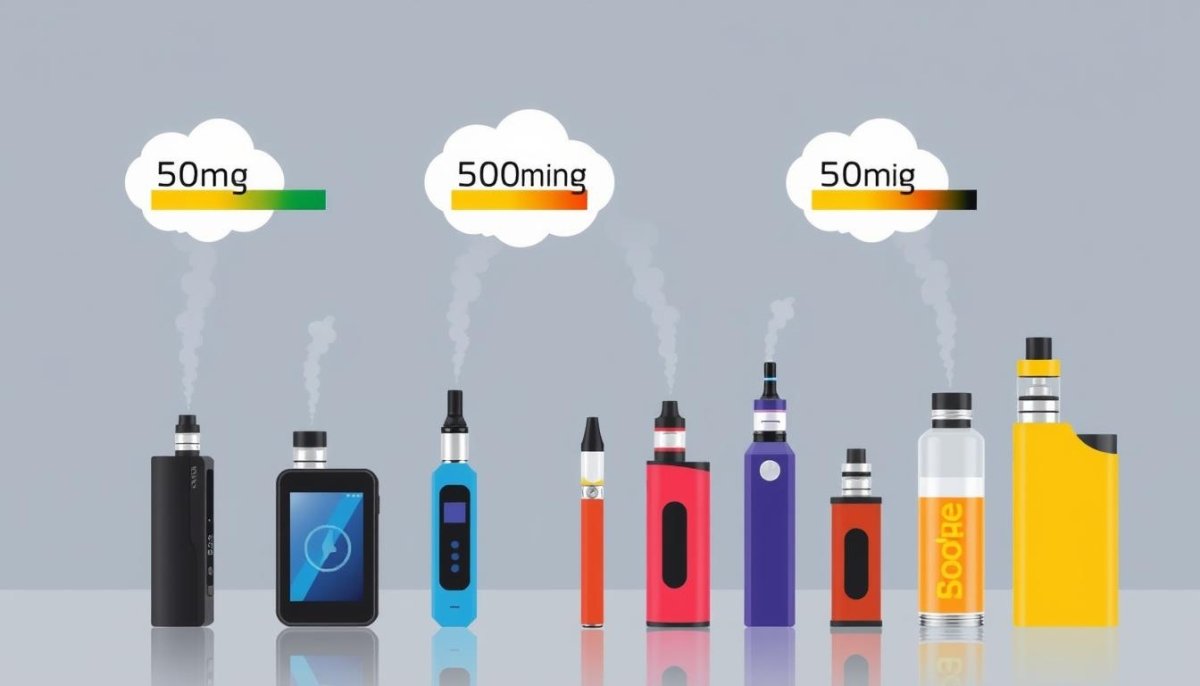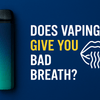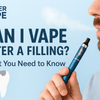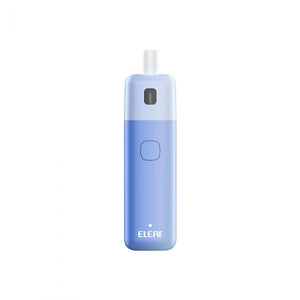How Much Nicotine Is In a Vape: A Complete Guide

How Much Nicotine Is In a Vape: A Complete Guide
Did you know that 15 puffs of an e-cigarette can have 0.5-15.4mg of nicotine? With so many e-liquids available, from 0mg to 20mg, finding the right one can be hard. This guide will help you understand nicotine levels in vaping products. It's all about making choices that fit your needs and likes.
Key Takeaways
- E-liquid nicotine strengths commonly span from 0mg to 20mg, with options like 3mg, 6mg, and 12mg in between.
- The average cigarette contains approximately 12mg of nicotine, while the nicotine content in vape products can vary significantly.
- Nicotine strengths of 10mg to 12mg are suitable for individuals who smoke up to a pack a day, while 18mg to 20mg are for heavy smokers exceeding a pack a day.
- Gradually reducing nicotine strength over time is a recommended approach for transitioning from smoking to vaping.
- Storing e-liquids correctly is essential for maintaining flavour and prolonging their lifespan.
Understanding Nicotine and Its Effects
Nicotine is a chemical found in tobacco plants. It's a strong stimulant that affects the body deeply. It's known to be addictive, impacting both mind and body.
What is Nicotine?
Nicotine is very addictive and acts as a brain stimulant. It releases dopamine, making us feel good. This is why quitting tobacco or vaping nicotine is hard.
How Nicotine Affects the Body
Nicotine quickly gets into the blood and reaches the brain. There, it binds to receptors and releases dopamine. This feeling of pleasure can lead to addiction. Long-term use can harm the heart, lungs, and overall health.
Nicotine Tolerance Levels
How much nicotine someone needs can vary a lot. It depends on genetics, how often they use it, and past experiences. Some need more to feel the effects, while others are more sensitive. Knowing your tolerance is key to managing cravings and understanding vaping risks.
"Nicotine is a highly addictive substance that can have far-reaching consequences on both physical and mental health. Recognising the risks and understanding the effects of nicotine is essential in making informed decisions about its use."
Dealing with nicotine addiction and vaping risks is complex. It's important to find reliable info and support. Knowing how nicotine affects the body helps make better health choices.
Types of Vape Products Available
The world of vaping offers a wide range of products. These cater to different preferences and needs. From rechargeable kits to disposable vapes, the market has grown a lot. Let's look at the different types of vape products and what makes them special.
E-liquids and Their Composition
E-liquids are at the core of vaping. They are made from propylene glycol (PG), vegetable glycerin (VG), flavourings, and sometimes nicotine. The mix of PG and VG affects the vapour's feel and taste.
Disposable Vapes
Disposable vapes are popular for their ease of use. They come pre-filled with a set nicotine level and flavours. Brands like Elf Bar 600 and Nasty Bar by Nasty Juice are favourites in the UK. They're great for a quick vape or for new users.
Pod Systems
Pod systems are known for their simple design. They have a battery and a pod that holds the e-liquid and coil. Beginners often choose them for their ease and small size. They provide a steady vaping experience.
| Vape Product Type | Features | Popularity | Nicotine Levels |
|---|---|---|---|
| Disposable Vapes | Pre-filled, single-use devices | High | 10mg, 20mg |
| Pod Systems | Compact, user-friendly design | Moderate to High | Varies |
| E-liquids | Blend of PG, VG, flavourings, and nicotine | High | Varies |
Vapers have many options to choose from. There are disposable vapes, pod systems, and e-liquids. Each offers something unique. Exploring these can help find the perfect vape for you.
Measuring Nicotine Concentration
Understanding the nicotine in your e-liquid is key when vaping. Nicotine levels are shown in milligrams per millilitre (mg/ml) or as a percentage. For example, a 3mg/ml e-liquid has 0.3% nicotine, and a 20mg/ml e-liquid has 2%.
It's important to know these measurements. This helps you choose the right nicotine strength for you.
Common Measurements Used in Vaping
- Milligrams per millilitre (mg/ml): This is the most common way to express nicotine concentration in e-liquids. The UK's limit for nicotine in e-liquids is 20mg/ml.
- Percentage (%): Some manufacturers may also list the nicotine content as a percentage. For example, 3mg/ml is equivalent to 0.3%.
Comparing Nicotine Levels Across Products
Nicotine levels in vaping products can be compared to traditional cigarettes. However, the way nicotine is absorbed and delivered is different. Cigarettes have 8-20mg of nicotine, but only 1-2mg is absorbed per cigarette.
In the UK, e-liquids can have up to 20mg/ml of nicotine. This is similar to the higher nicotine levels in cigarettes.
| Product | Nicotine Content |
|---|---|
| Cigarettes | 8-20mg per cigarette |
| E-liquids (UK) | 0-20mg/ml |
| Disposable Vapes | 20mg/ml (total of 40mg) |
| Prefilled Pod Kits | Various nicotine levels available |
| Refillable Vape Kits | Customisable nicotine levels |
Knowing about nicotine measurements helps vapers make better choices. It ensures they pick the right nicotine level for their needs and preferences.
Typical Nicotine Levels in Vaping Products
Vaping involves choosing e-liquids with the right nicotine level. These liquids come in various strengths to suit different vapers. Knowing the typical nicotine levels helps you make a better choice.
Low, Medium, and High Nicotine Options
E-liquids have nicotine from 0mg (no nicotine) to 20mg per millilitre. Common levels are:
- Low: 3mg and 6mg
- Medium: 12mg
- High: 18mg and 20mg
People choose nicotine levels based on their smoking history and taste. Light smokers might prefer lower levels. Heavier smokers might need higher levels to feel satisfied.
Understanding Salt Nicotine vs. Freebase Nicotine
There are two main types of nicotine in e-liquids: salt nicotine and freebase nicotine. Salt nicotine is smoother and can be up to 20mg/ml. Freebase nicotine is harsher and usually lower in strength.
Choosing between salt and freebase nicotine depends on what you like and your device. Salt nicotine is good for beginners. Freebase nicotine offers more options for experienced users.
| Nicotine Type | Typical Nicotine Strengths | Throat Hit |
|---|---|---|
| Salt Nicotine | Up to 20mg/ml | Smoother |
| Freebase Nicotine | 3mg to 12mg/ml | Harsher |
Choosing the right nicotine level and type is personal. It depends on your smoking history, device, and vaping experience. Experimenting helps find the best balance for a great vaping experience.
Choosing the Right Nicotine Level for You
When you start vaping, picking the right nicotine level is key. Your smoking history helps decide the best nicotine strength for you. Light smokers might prefer 3-6mg e-liquids, while heavy smokers might need 18-20mg to curb cravings.
Factors to Consider
Other things to think about include your preferred throat hit and the vaping device you use. Sub-ohm coils need lower nicotine, like 3-6mg, to avoid a harsh taste. Mouth-to-lung devices, however, can handle higher levels, like 12-18mg, for a more satisfying feel.
Transitioning from Cigarettes to Vaping
Disposable vapes are great for those quitting cigarettes. They usually have 10-20mg nicotine, helping to quickly satisfy cravings. As you get used to vaping, you can lower the nicotine level to find what works best for you.
Tips for Beginners
- Begin with 12-18mg nicotine and gradually lower it.
- Try different nicotine levels to see what feels best.
- Nicotine salts offer a smoother hit and can be used at higher levels without harshness.
- Listen to your body and adjust nicotine levels to avoid too much or too little.
Finding the right nicotine level is a personal journey. Think about your smoking history, device preferences, and how you feel. This will help you find the perfect balance for a successful transition to vaping.
Myths and Facts About Nicotine in Vapes
There are many myths and misconceptions about nicotine in vaping. It's important to know the truth to make smart choices about vaping.
Common Misconceptions
One big myth is that nicotine causes cancer. Nicotine is addictive but doesn't cause cancer. Four out of 10 smokers believe nicotine causes most tobacco smoking-related cancers. But, it's the thousands of other chemicals in tobacco smoke that really cause health problems.
Another myth is that vaping is as bad as smoking. The UK has strict rules for e-cigarettes. Studies show that nicotine vapes help people quit smoking. A big UK study found e-cigarettes are twice as good at helping smokers quit as other nicotine products.
The Truth About Nicotine Addiction
Nicotine addiction is a big issue, but vaping can help people slowly cut down. More than half of e-cigarette users in the UK have stopped smoking. And over 770,000 users in the UK have quit both smoking and vaping. Vaping has helped lower the smoking rate in England to 14.9%.
Nicotine isn't the worst part of tobacco smoke; it's the other chemicals. Switching to vaping can greatly reduce exposure to these harmful substances.
"Evidence suggests that nicotine vapes are effective for smoking cessation and reduction."
Understanding the truth about nicotine in vapes can help people make better health choices. As the UK leads in vaping research and regulation, it's key to stay informed with the latest findings.
Health Implications of Vaping
Vaping's popularity is growing, but so are health concerns. Many think vaping is safer than smoking. Yet, the risks of nicotine and vaping are real.
Is Vaping Safer Than Smoking?
Vaping has fewer harmful chemicals than smoking. But, it's not completely safe. The e-cigarette aerosol can still harm you. The long-term effects are not fully known.
Using both e-cigarettes and regular cigarettes can be worse. It leads to more toxins and health problems than using one or the other.
Long-term Effects of Nicotine Consumption
Nicotine in vaping and smoking can harm your health. It can raise your heart rate and blood pressure. This increases the risk of heart diseases.
Nicotine addiction in young people can lead to addiction to other drugs. This is a serious concern.
The Role of Nicotine in Withdrawal Symptoms
Nicotine makes quitting hard because of withdrawal symptoms. These include irritability, anxiety, and trouble concentrating. Reducing nicotine in vapes helps manage these symptoms.
While vaping is less harmful than smoking, it's still risky. We need more research and education. This helps people understand the risks and make better choices for their health.
| Health Concern | Vaping vs Smoking |
|---|---|
| Toxic Chemicals | Vaping generally exposes users to fewer harmful chemicals than traditional cigarettes. |
| Cardiovascular Health | Nicotine in both vaping and smoking can increase heart rate and blood pressure, leading to increased risk of cardiovascular diseases. |
| Respiratory Health | Dual use of e-cigarettes and regular cigarettes may result in worse respiratory health outcomes than using either product alone. |
| Nicotine Addiction | Nicotine addiction among youth using vapor products may lead to an increased risk of future addiction to other drugs. |
"Compared to traditional cigarettes, vaping generally exposes users to fewer harmful chemicals. However, this does not make vaping completely safe."
Vaping Trends in the UK
Vaping has become very popular in the UK, especially among young adults. The number of children trying vaping has gone up by 50% in a year. Now, 20.5% of children have tried vaping, up from 15.8% in 2022 and 13.9% in 2020.
Popularity Among Young Adults
Vaping is popular across different age groups. 15% of 11-15 year olds, 34% of 16-17 year olds, and 38% of 18 year olds have tried it. Since 2021, more people vape than smoke, with 7.6% vaping and 3.7% smoking in 2023.
Regulatory Changes and Their Impact
The UK's vaping rules have changed a lot. The Tobacco Products Directive (TPD) limits e-liquids to 20mg/ml of nicotine. These rules have changed what products are available and how they are packaged. But, the UK still sees vaping as a good way to stop smoking, unlike some other countries.
| Key Vaping Statistics in the UK | 2022 | 2023 | 2024 |
|---|---|---|---|
| Proportion of children who have tried vaping | 15.8% | 20.5% | N/A |
| Proportion of current vapers among the population | 10% | 11% | 11% |
| Proportion of ex-smokers who are current vapers | 65% | 53% | N/A |
These trends show how vaping in the UK is changing. Rules and more people seeing vaping as a way to quit smoking are shaping this change.
Understanding PG and VG in E-liquids
Propylene Glycol (PG) and Vegetable Glycerin (VG) are key in vape juice. They affect nicotine delivery and the vaping experience. Knowing about PG and VG helps vapers choose the right PG VG in e-liquids.
What Are PG and VG?
PG and VG are main ingredients in vape juice composition. PG is clear and carries flavours well, giving a strong throat hit. VG is thicker and sweeter, making more visible vapour.
Their Role in Nicotine Delivery
The PG to VG ratio changes the nicotine delivery and vaping feel. More PG is good for mouth-to-lung vaping and strong nicotine. More VG is for direct-to-lung vaping, with big clouds and a smoother feel.
Choosing between PG and VG depends on what you like. Try different PG VG in e-liquids to find your best match.
"The majority of vapers, either new or experienced, do not experience any issues with PG/VG e-liquids."
Tailoring Your Vaping Experience
The vaping world is full of options for making your vaping experience your own. You can change nicotine levels or try different e-liquid flavours. This lets you make your vaping journey special.
Customising Nicotine Levels
Vapes have nicotine levels from 0mg to 20mg. This range meets many needs. If you want to cut down on nicotine, try levels from 0mg to 6mg.
For most vapers, 10mg to 12mg is just right. If you need a stronger hit, go for 18mg to 20mg.
Being able to customise nicotine levels helps you find what works best for you. It's great for those moving from cigarettes or just trying vaping.
Choosing Flavours That Suit Your Preference
The vaping world is full of e-liquid flavours. You can find everything from fruity to menthol and tobacco flavours. Trying different flavours can help you find your favourite.
The RELX Pod Pro has many flavours, like Watermelon Ice and Juicy Apple. It also has Mango Orange, Menthol Plus, and Menthol Extra. This variety helps you customise your vaping experience.
By trying out many flavours, you can make your vaping journey unique. You'll find the perfect flavour that suits your taste.
"Vaping lets me tailor my experience in ways traditional cigarettes can't. Adjusting nicotine levels and trying new flavours makes vaping rewarding."
The Future of Vaping and Nicotine Research
The vaping world is changing fast. Research is uncovering the health effects of e-cigarettes and their role in quitting smoking. New studies are looking into how different ways of using nicotine affect our health.
Emerging Studies and Findings
Recent studies have shown vaping can be risky, especially for young people. They found e-cigarette users are more likely to start smoking. One study showed e-cigarette users were 6.17 times more likely to start smoking than those who didn't use them.
But, vaping might help adult smokers quit. In the UK, a survey showed fewer teens tried cigarettes than e-cigarettes in 2014. Only 9.2% of teens tried cigarettes, while 13.4% tried e-cigarettes.
Changes in Public Perception
People's views on vaping are changing. More see it as a way to reduce harm for smokers. In 2021, only 34% of smokers knew vaping was less harmful than smoking. This shows we need to educate more people.
New research could shape vaping laws and policies. It's important to share accurate, scientific info. This will help shape the vaping industry's future and its impact on health.
"Ongoing research is crucial in understanding the long-term impacts of vaping and informing future policies and regulations."
| Statistic | Value |
|---|---|
| Current smoking prevalence among 11 to 18 year olds in England in 2022 | 6% |
| Current vaping prevalence among 11 to 18 year olds in England in 2022 | 8.6% |
| Vaping prevalence among adults in England in 2021 | 6.9% to 7.1% |
| Quit attempts involving a vaping product in stop smoking services had a success rate in 2020 to 2021 | 64.9% |
Support for Those Looking to Quit Nicotine
Quitting nicotine addiction is tough, but many resources and support systems can help. The NHS and helplines offer tools and guidance to break free from nicotine. This journey can be easier with the right help.
Resources and Hotlines Available
The NHS provides stop smoking services across the UK. These services offer one-on-one counselling, group sessions, and nicotine replacement therapies. The NHS Smokefree Helpline also offers advice and support for quitting vaping or smoking.
Seeking Professional Help
Healthcare professionals can be a big help when quitting nicotine. GPs and pharmacists give tailored advice and support. They can help with nicotine addiction help and vaping cessation support.
Reducing nicotine levels in e-liquids is a key method for quitting. With healthcare support and vaping cessation support, quitting nicotine is more likely. This can lead to long-term abstinence.
Support groups and online communities are also helpful. They offer a sense of community and shared experiences. They provide additional resources to help overcome addiction.
"Using a nicotine vape makes you roughly twice as likely to quit smoking compared to other nicotine replacement products like patches or gum."
With the right support and determination, quitting nicotine is possible. By using available resources and vaping cessation support, individuals can start a healthier, smoke-free life. This is the first step towards a brighter, nicotine-free future.
Vaping in Public Spaces
Vaping is getting more popular in the UK. It's key to know the laws and etiquette for using it in public. Even though vaping isn't banned like smoking, places have their own rules.
Legal Regulations in the UK
The UK has rules for e-cigarettes, called the Tobacco and Related Products Regulations. These rules are important to follow:
- You must be 18 or older to buy and use vape products.
- Vape cartridges can't hold more than 2ml of e-liquid or have more than 20mg of nicotine per ml.
- E-liquid bottles can't be bigger than 10ml.
- Vape tanks can't hold more than 2ml.
- The strongest e-liquid allowed is 2% (20mg/ml) nicotine.
- Driving while vaping can lead to losing up to nine points on your licence and a fine of up to £5,000.
Vaping Etiquette
It's not just about the laws. Vapers should also think about others in public. Good vaping etiquette includes:
- Don't vape in crowded or closed places where vapour might disturb others.
- Follow any "no-vaping" signs or rules at places you visit.
- Think about how vaping might affect people with breathing problems or allergies.
- Don't vape near children or young people.
- Dispose of e-cigarette waste, like empty cartridges, properly.
Knowing the UK's vaping laws and being considerate helps vapers enjoy their habit. It also makes sure everyone feels safe and comfortable.
| Regulation | Requirement |
|---|---|
| Minimum Age | 18 years old |
| Vape Cartridge Capacity | Max 2ml |
| Nicotine Concentration | Max 20mg/ml |
| E-liquid Bottle Capacity | Max 10ml |
| Vape Tank Capacity | Max 2ml |
| Driving Violation Penalty | Up to 9 license points and £5,000 fine |
"Vaping is getting more popular, but we must follow the rules and be respectful. By doing so, we can all enjoy vaping in a safer and more considerate way."
Understanding Vaping Devices
Vaping devices are changing fast. They have many parts and features that affect how you vape. Knowing the basics and how to keep your device in good shape is key to a great vaping experience.
Basic Components of a Vape Device
Vape devices have three main parts:
- Battery: This is the power source. It heats the atomiser and makes vapour.
- Atomiser: It's the heating part that turns e-liquid into vapour.
- E-liquid Tank: This holds the e-liquid. It gets drawn into the atomiser and vaporised.
Some devices also have extra parts. These include airflow controls, LED lights, and settings for wattage or voltage. They let you change your vaping experience.
Maintaining Your Device for Optimal Performance
Keeping your vape device in good shape is important. Cleaning, replacing coils, and caring for the battery are key steps:
- Cleaning: Clean the tank, atomiser, and other parts often. This removes residue and keeps flavour and vapour quality up.
- Coil Replacement: Change the coil when it wears out or flavour drops. It's the heating part in the atomiser.
- Battery Care: Make sure the battery is charged right and stored well. Replace it if it loses power over time.
Looking after your vape device helps it last longer. It also makes vaping better and ensures you enjoy your vape device components, e-cigarette maintenance, and vaping technology.
"Proper care and maintenance of your vape device is essential for a consistent, enjoyable vaping experience."
FAQs About Nicotine and Vaping
The vaping world is always changing, leading to many questions about nicotine. We aim to clear up some common doubts. This will help you understand vaping better.
Common Questions Answered
How much nicotine is in a vape product? The amount can vary a lot. Some JUUL pods have as much nicotine as 20 cigarettes. Brands like JUUL use nicotine salts, which give you a quicker hit.
Is vaping safer than smoking? Vaping is less harmful than smoking, but it's not completely safe. It can cause lung injuries and the long-term effects are still being studied.
How do I pick the right nicotine level? When switching from smoking to vaping, finding the right nicotine level is key. Start with a medium or low strength, based on your smoking habits. Then, adjust as you see fit.
Resources for Further Information
For the latest on vaping and nicotine, check out the NHS website and scientific journals. Also, look at organisations like Action on Smoking and Health (ASH) and the UK Vaping Industry Association (UKVIA). They offer the latest, evidence-based info to guide your vaping choices.
"It's important to stay informed about the latest research and regulations in the rapidly evolving vaping industry."
Conclusion: Making Informed Vaping Choices
As we wrap up this guide on nicotine levels in vaping, it's clear that making smart choices is key. Understanding e-cigarettes and vaping needs a balanced view. This view should weigh your likes and potential health risks.
Finding Your Balance with Nicotine
Finding the right nicotine level is a personal journey. Your smoking history, how much you can handle, and what you want from vaping should guide you. By trying different levels and watching how you feel, you can find the perfect balance.
Encouraging a Mindful Approach to Vaping
Using e-cigarettes responsibly means looking after your health. It's about checking how much nicotine you're using, keeping up with new research, and thinking about your nicotine goals. Staying informed helps you make choices that fit your health and goals.
FAQ
How much nicotine is typically found in a vape?
On average, 15 puffs of an e-cigarette have 0.5-15.4mg of nicotine. E-liquids come in various nicotine strengths, from 0mg to 20mg. You can find options like 3mg, 6mg, and 12mg in between.
What is nicotine and how does it affect the body?
Nicotine is a stimulant from tobacco plants. It boosts mood and causes addiction by releasing dopamine in the brain. It's found in tobacco and e-liquids. Vaping is seen as less harmful than smoking because it has fewer harmful substances.
Nicotine levels can vary among people. This affects their choice of vape strength.
What types of vape products are available?
You can find rechargeable kits and disposable vapes. E-liquids have flavourings, propylene glycol, vegetable glycerine, and optional nicotine. Disposable vapes come pre-filled with 10mg and 20mg nicotine.
Popular brands include Elf Bar 600, Nasty Bar by Nasty Juice, and Pod BM600 by Lost Mary. They offer different flavours and puff counts.
How is nicotine concentration measured in vaping?
Nicotine in e-liquids is measured in milligrams per millilitre (mg/ml) or as a percentage. For example, 3mg/ml is 0.3%, while 20mg/ml is 2%. It's important to understand these measurements to choose the right nicotine strength.
Nicotine levels in vapes can be compared to traditional cigarettes. However, absorption rates and delivery methods vary.
What are the typical nicotine levels in vaping products?
E-liquids come in various nicotine strengths. You can find 0mg (nicotine-free), 3mg (low), 6mg (low to medium), 12mg (medium), and 18-20mg (high). Salt nicotine e-liquids offer higher nicotine concentrations with a smoother throat hit.
The choice depends on your smoking habits and nicotine tolerance levels.
How do I choose the right nicotine level for me?
Choosing the right nicotine level depends on your smoking habits. Light smokers might start with 3-6mg, while heavy smokers might need 18-20mg. Consider your throat hit preference and device type.
Beginners should start with higher nicotine levels and gradually reduce them. Disposable vapes can be a good starting point for those transitioning from cigarettes.
Are there any myths or misconceptions about nicotine in vapes?
Some believe nicotine causes cancer. However, nicotine itself is not a carcinogen. Vaping is often misunderstood as equally harmful as smoking, but it contains fewer harmful substances.
Nicotine addiction is real, but vaping allows for gradual reduction in nicotine intake. This can help in smoking cessation.
What are the health implications of vaping?
While not risk-free, vaping is considered less harmful than smoking due to lower levels of toxic substances. Long-term effects include increased heart rate and blood pressure. Nicotine plays a significant role in withdrawal symptoms, which can be managed by gradually reducing nicotine levels in vapes.
More research is needed on the long-term health effects of vaping.
What is the state of vaping in the UK?
Vaping has gained popularity in the UK, especially among young adults. The Tobacco Products Directive (TPD) restricts nicotine content in e-liquids to a maximum of 20mg/ml. Regulatory changes have impacted product availability and packaging.
The UK government has shown a more positive stance towards vaping as a smoking cessation aid compared to some other countries.
What is the role of PG and VG in e-liquids?
Propylene Glycol (PG) and Vegetable Glycerin (VG) are base ingredients in e-liquids. PG provides a stronger throat hit and carries flavours better, while VG produces more vapour. The PG/VG ratio affects nicotine delivery and vaping experience.
Higher PG ratios are often preferred for higher nicotine strengths and mouth-to-lung vaping.
How can I customise my vaping experience?
You can customise your vaping experience by adjusting nicotine levels and choosing from a wide range of flavours. Shortfill e-liquids and nicotine shots allow for precise nicotine strength adjustment. Popular flavours include fruit, menthol, and tobacco.
Experimenting with different combinations helps find the ideal vaping experience.
What is the future of vaping and nicotine research?
Ongoing research focuses on long-term health effects of vaping and its efficacy as a smoking cessation tool. Emerging studies are exploring the impact of different nicotine delivery methods. Public perception of vaping is evolving, with increasing recognition of its potential benefits for smokers trying to quit.
Future regulations may be influenced by new scientific findings.
Where can I find support for quitting nicotine?
Various resources are available for those looking to quit nicotine, including NHS stop smoking services and dedicated helplines. Professional help from healthcare providers can offer personalised strategies for nicotine cessation. Gradual reduction of nicotine levels in vapes can be an effective method for quitting.
Support groups and online communities provide additional assistance.
What are the rules and etiquette around vaping in public spaces?
UK regulations on vaping in public spaces vary by location. While not covered by the smoking ban, many businesses and public areas have their own policies. Vaping etiquette includes being mindful of others, avoiding vaping in crowded areas, and respecting no-vaping signs.
It's important to check local rules before vaping in public.
How do I maintain my vape device for optimal performance?
Vape devices typically consist of a battery, atomiser, and e-liquid tank. Understanding these components helps in proper maintenance and troubleshooting. Regular cleaning, coil replacement, and battery care are essential for optimal performance.
Different devices may be better suited for various nicotine strengths and vaping styles.
Where can I find more information about nicotine and vaping?
Common questions include the safety of vaping, nicotine strength recommendations, and how to choose the right device. Reliable resources for further information include NHS websites, scientific journals, and reputable vaping organisations. It's important to stay informed about the latest research and regulations in the rapidly evolving vaping industry.






